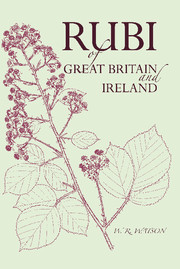Book contents
- Frontmatter
- Foreword
- Preface
- Contents
- INTRODUCTION
- I Environmental variations
- II Genetic intraspecific variations
- III Chromosomes and genes
- IV Reproduction
- V The species in Rubus
- VI Ecesis and migration
- VII Enemies, pests and diseases
- VIII Classification
- IX Collection and identification
- X Characteristics of the British-Irish bramble flora
- XI Cultivating native blackberries for fruit
- XII Note on the nomenclatural type species for the genus Rubus and subgenus Rubus
- XIII Key to the vice-county numbers
- XIV Signs and abbreviations
- ARRANGEMENT OF THE GENUS RUBUS LINN. IN AN ANALYTICAL KEY
- DESCRIPTIONS
- DRAWINGS
- Glossary
- Principal works consulted
- Index
I - Environmental variations
Published online by Cambridge University Press: 05 June 2016
- Frontmatter
- Foreword
- Preface
- Contents
- INTRODUCTION
- I Environmental variations
- II Genetic intraspecific variations
- III Chromosomes and genes
- IV Reproduction
- V The species in Rubus
- VI Ecesis and migration
- VII Enemies, pests and diseases
- VIII Classification
- IX Collection and identification
- X Characteristics of the British-Irish bramble flora
- XI Cultivating native blackberries for fruit
- XII Note on the nomenclatural type species for the genus Rubus and subgenus Rubus
- XIII Key to the vice-county numbers
- XIV Signs and abbreviations
- ARRANGEMENT OF THE GENUS RUBUS LINN. IN AN ANALYTICAL KEY
- DESCRIPTIONS
- DRAWINGS
- Glossary
- Principal works consulted
- Index
Summary
There is no escape: since we cannot be the masters of Nature, nor create the plants afresh after our own idea, we must submit to the laws of Nature, and by intelligent application learn the characters that are inscribed upon plants.
linnaeus, Genera Plantarum (1764, 6th ed.)One does not know much about brambles, until one has mastered the range of changes a bramble plant undergoes due to age, season, climate, exposure, soil, habitat and so on; neither is it possible for a given bush or specimen to be named intelligently by comparison with another specimen or figure unless one knows how to allow for these modifying influences. One may instance particularly the deep shade of woods, an excess or deficiency of soil moisture, atmospheric moisture, a spell of hot weather, a run of cool rain, a shallow soil overlying rock or iron pan, exposure to salty sea breezes, a frost in May, lopping in hedgerows. The effects of these factors are discovered by observation of the brambles growing under such conditions. That they are of practical concern a few instances may prove.
R. carpinifolius sometimes grows in marshes and is then apt to make lax panicles and somewhat laciniated leaflets. Such a specimen was named R. leucandrus by Focke, and another R. carpinifolius var. laxus by Sudre. R. lacustris Rogers found in Lakeland is a wet-soil form of R. Lindebergii. R. vestitus growing in woods so far deceived Babington that he published it as a new species, R. Leightonianus, and was corrected by Leighton. Salter was only stopped by Borrer from describing wood-land R. vestitus as a new species, R. rotundifolius. R. ericetorum var. cuneatus Rogers & Ley is the same as R. ericetorum of Rogers. R. ericetorum ssp. sertiflorus var. scoticus Rogers & Ley is the same as sertiflorus of Rogers. R. botryeros Focke, at first associated with R. longithyrsiger by both Focke and Rogers, is the same as R. oegocladus of Rogers. Rogers repeats R. dumnoniensis Bab. under the name of R. cariensis Rogers (not Genev.). Sudre has this bramble under four names. The bramble which Rogers has as.R. Borreri, Sudre has figured under that name and again under R. retrodentatus; he has described it also as R. Schmidelyanus var. breviglandulosus.
These faults are due to remissness in observing the behaviour of the species in different environments.
- Type
- Chapter
- Information
- Publisher: Cambridge University PressPrint publication year: 2013



